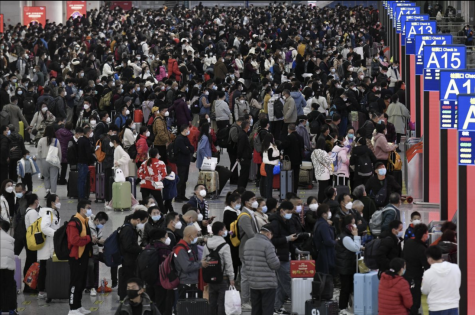The Vietnamese STEM Program: Empowering Girls to Change the World?
As 14-year-old Vang Thi Thu Ha listens to her male science teacher talk about genetics in a small school in the seventh poorest province in Vietnam known as Lao Cai, she wonders if she would ever become a science teacher. Pictures of Albert Einstein, Charles Darwin, and Nikola Tesla hang on the wall, but there are no pictures of women. She turns her attention back to the teacher who points to a diagram of a biological structure and asks the class if they know what it is. She knows the answer but doesn’t raise her hand. In Vietnam, half of all universities employ women and only eleven percent receive professorships. What is the point in trying if she has no role model to inspire her to become a scientist?
65% of the population of Lao Cai come from ethnic groups such as the Dao, Mong, and Tay tribes and it is indisputable that these children are not experiencing the same level of education as the rest of Vietnam. Girls in these ethnic groups do not get the same opportunities as girls in other parts of Vietnam because they may need to help their mothers take care of their siblings or they get married at a young age.
In many schools around the world, there are programmes designed to guide students towards a more science or math-based career. This programme is known as the STEM programme (science, technology, engineering, and mathematics) program and it was first introduced in 2001 by scientific administrators at the U.S. National Science Foundation. However, schools in Vietnam do not have the proper resources, such as textbooks or qualified STEM teachers, to provide girls with opportunities that might change their futures.
In Vietnam, girls that belong to rural communities are particularly disadvantaged because they never have the opportunity to study STEM subjects at a higher level in high school and university. The Chief of Education for UNICEF, Simone Vis, explained that only 30% of Vietnam’s poorest students continue to middle school and 90% of those students reach high school. The children that do not continue on to secondary school stay home and help the family. However, even students who do receive secondary education lack the chance to participate in the STEM Program because rural schools cannot fund science labs or equipment needed for an engineering class. There are also not enough teachers for many schools in rural Vietnam. According to Vietnam News, some math classes don’t have a math teacher for several months or even years. They have to be replaced with a teacher who might specialize in English or Geography. Vang Thi Thu Ha mentioned that her best friend who lived in the remote Bac Ha district said that her primary school hadn’t had trained maths teacher in two years. Without qualified teachers, the students won’t be able to learn the skills of said topic and won’t be able to pursue further study.
Vis explained why STEM has not yet been introduced to public schools and what UNICEF is trying to do about it. “When you introduce a new approach of teaching, you need all of the teachers to understand it and you need the curriculum, the textbooks, the exams, and assessments to assess what the children are learning,” she said. Currently, many teachers are not trained to help and teach students to think creatively, solve problems, and embrace their curiosity for learning. This is why it is difficult to introduce STEM programs into schools in Vietnam.
Furthermore, teachers who went to the best teaching schools in Vietnam or elsewhere usually end up teaching in the more developed and rich regions in Vietnam such as Hanoi, Ho Chi Minh City, or Danang. This contributes to the shortage of qualified teachers in poor neighborhoods or rural villages. On top of that, the textbooks include famous male scientists or male mathematicians, making these STEM subjects far less desirable to the female students. It seems that STEM careers are mainly targeted towards men.
In many advantaged schools or public schools in Hanoi, there are STEM clubs.
The teachers know that they can’t teach it as part of the curriculum because they lack the tools and knowledge to teach and assess these topics, so they made a club for those who are interested. However, the students have to pay around 120 USD per month to join. This creates the same problem that disadvantaged children cannot join these clubs as the cost of the club may be their parents’ monthly income. To ensure that all students can join these clubs, UNICEF hopes to persuade the Ministry of Education to find a way to make these clubs accessible to all students regardless of their financial background. They want to try to integrate these STEM courses into the curriculum so that it can be considered as its own subject, instead of having expensive and exclusive clubs.
STEM has just been introduced to UNIS, bringing along with it a new subject, Engineering. Before STEM was introduced, the STEM-related subjects were separated and were rarely emphasized during class. Now, we have more crossovers between the four subjects (math, science, technology, and engineering) which makes the UNIS school programme a STEM programme. Some of the crossovers may include a maths class that uses engineering and math to build a bridge or a science class that uses math to calculate a volume of a chemical. These crossovers are important for students to use their STEM skills to solve problems from a variety of subjects.
Sarah Schneider, the STEM teacher at UNIS, became interested in pursuing a STEM career from a young age.
“I was inspired to study math and science from early on, as I was both interested in it and typically did very well in these courses. It took me a while to figure out that I wanted to teach these subjects.”
Recently, the arts have been included in the program as there is always a creative element in each of the STEM subjects. Many STEM programmes are now referred to as STEAM programmes.
Sarah Schneider explained that even if a student does not want to pursue a career in STEM topics, the subject could still aid them to learn how to solve everyday problems.
In 2015, research conducted by the Organisation for Economic Co-operation and Development (OECD) showed that girls score higher on the Programme for International Student Assessment (PISA) test in Vietnam. The PISA test intends to measure 15-year-old school pupils’ scholastic performance in mathematics, science and reading. Vietnamese girls typically scored around 3 points more than the boys. The girls were better in the STEM subject portion of the test. This means that although many girls may be more competent at STEM subjects than boys, they are rarely encouraged or taught the necessary skills that are needed to pursue these vastly important careers. When asked whether girls receive any encouragement to pursue STEM careers, Vang Thi Thu Ha responded saying “neither girls nor boys are discouraged to have a career in STEM. It is just that girls are never particularly encouraged.”
Citation:
https://vietnamnews.vn/society/417457/vn-needs-more-women-working-in-stem-experts.html#0HB4GYV0cEkSOoXv.97


